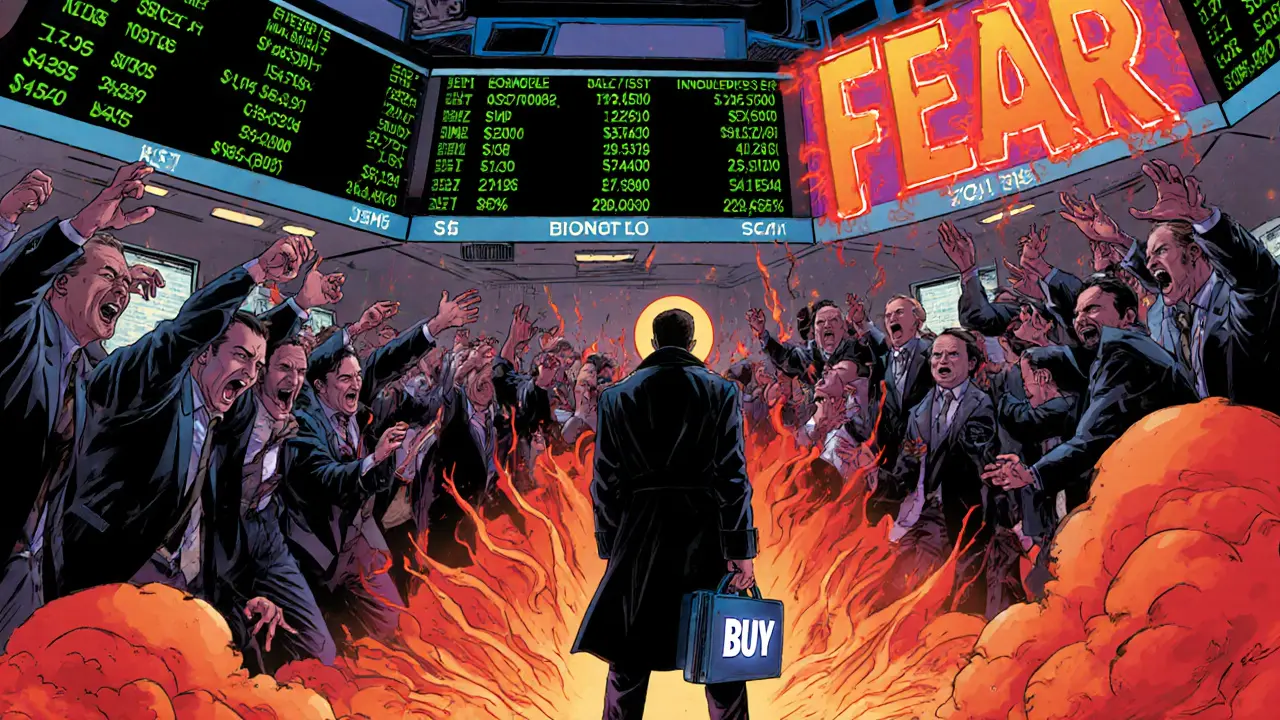Contrarian Sentiment Indicator Tracker
VIX Analysis
Current VIX: 25
Put/Call Ratio
Current Put/Call Ratio: 1.0
AAII Survey
Current AAII Bullish: 45%
BPI Analysis
Current BPI: 55%
Overall Sentiment Assessment
Enter values and click Analyze to see sentiment assessment
When sentiment indicators show extreme readings, it often indicates a potential market turning point:
- Extreme Fear (VIX > 30): Often signals buying opportunity
- Extreme Greed (VIX < 5): Often signals selling opportunity
- High Put/Call Ratio (>1.0): Indicates excessive bearish sentiment
- Low Put/Call Ratio (<0.8): Indicates excessive bullish sentiment
- AAII Overbullish (>60%): Market may be overextended
- AAII Oversold (<30%): Potential market bottom
- BPI Extreme Bullish (>70%): Potential reversal signal
- BPI Extreme Bearish (<30%): Potential upside
When most traders are chasing the latest hype, a small but growing group does the opposite: they buy when everyone is terrified and sell when euphoria peaks. This is the core idea behind contrarian investing, but the modern twist adds a data‑driven layer - sentiment analysis. By quantifying fear and greed, investors can spot price extremes before the market corrects itself.
- Identify the most reliable sentiment indicators (VIX, AAII survey, Put/Call Ratio, BPI).
- Apply a multi‑timeframe framework to separate temporary spikes from structural shifts.
- Blend sentiment signals with fundamental valuation to avoid value traps.
- Use strict position sizing and stop‑loss rules to manage the “catch‑the‑falling‑knife” risk.
- Leverage affordable tools (free surveys, StockTwits) or premium platforms (RavenPack, Bloomberg) based on your budget.
What Is Contrarian Sentiment Investing?
Contrarian sentiment investing is a systematic approach that takes positions opposite to prevailing market sentiment, using quantitative and qualitative metrics to flag emotional extremes. The strategy builds on Warren Buffett’s classic advice - be fearful when others are greedy and greedy when others are fearful - but enhances it with modern data sources such as social‑media chatter, news‑article sentiment scores, and market‑derived gauges like the VIX.
Why Sentiment Matters: The Psychology Behind the Numbers
Behavioral finance shows that investors are not always rational. Loss aversion makes people react more strongly to potential losses than equivalent gains, while herding amplifies trends. Dr. Richard Thaler famously warned that markets can stay irrational longer than a trader can stay solvent. When sentiment swings to extreme levels, prices often drift away from intrinsic value, creating the mispricings contrarian investors seek.
Recent data from the American Association of Individual Investors (AAII) shows bullish‑bearish spreads hitting 42.7percentage points in September2023 - the widest gap since the 2020 crash. Such polarization is a red flag that market psychology, not fundamentals, is driving price moves.

Core Sentiment Indicators and How to Read Them
The most widely followed gauges are easy to monitor and have proven historical predictive power. Below is a quick reference:
| Indicator | Typical Extreme Threshold | Signal Interpretation |
|---|---|---|
| CBOE Volatility Index (VIX) | >30 (fear) / <15 (complacency) | VIX above 30 suggests buying opportunities; below 15 warns of over‑optimism. |
| AAII Sentiment Survey | Bullish >57.5% or Bearish >55% | Extreme bullishness predicts negative 12‑month returns; extreme bearishness predicts upside. |
| Put/Call Ratio | >1.0 (bearish) / <0.7 (bullish) | High ratios flag fear; low ratios hint at complacent buying. |
| Bullish Percent Index (BPI) | <30% (oversold) / >70% (overbought) | Readings below 30% on major indices often precede rebounds. |
Each indicator works best when you compare it against valuation metrics. For example, a VIX reading above 30 combined with an S&P500 forward P/E under 15 historically yields positive 12‑month returns about 82% of the time.
Building a Multi‑Timeframe Sentiment Framework
Sentiment isn’t static. Short‑term spikes on Twitter can differ from medium‑term shifts in news headlines and long‑term changes in institutional surveys. A layered approach helps you confirm signals and avoid false alarms.
- Daily / Intraday: Track real‑time Twitter or StockTwits sentiment scores. Look for rapid swings beyond the 90th percentile.
- Weekly‑Monthly: Use news‑sentiment engines such as RavenPack or Bloomberg’s sentiment scores. A sustained negative trend over three weeks while fundamentals stay solid is a classic contrarian cue.
- Quarterly‑Yearly: Examine AAII surveys, institutional allocation data, and macro‑level BPI. Divergence between a bearish long‑term view and a bullish short‑term pulse often signals an impending reversal.
By aligning all three horizons, you can spot situations like the October2022 episode where short‑term fear drove the VIX to 32, but the S&P500 forward earnings outlook remained healthy, leading to a 24% upside over the next year.
Combining Sentiment with Fundamentals
Sentiment alone can lead you into “value traps” - stocks that look cheap because sentiment is low but have deteriorating fundamentals. The safest path pairs sentiment extremes with a solid intrinsic‑value estimate.
Steps:
- Identify a sentiment extreme using the table above.
- Run a discounted cash‑flow (DCF) or comparable‑company analysis to gauge intrinsic value.
- Confirm a margin of safety (typically 20‑30%).
- Check for a catalyst - earnings beat, dividend initiation, or sector rotation - that could ignite price recovery.
Research from Michael Mauboussin (2022) shows that adding a quality‑factor filter improves contrarian sentiment alpha from 2.4% to 3.2% annually.

Risk Management and Common Pitfalls
Even seasoned quants admit that “catch‑the‑falling‑knife” risk is the biggest enemy. Here are proven safeguards:
- Position sizing: Limit each contrarian bet to 1‑3% of portfolio equity.
- Stop‑loss bands: Set hard exits at 8‑10% loss; tighten to 5% if sentiment worsens further.
- Time limits: If a trade doesn’t improve after 2‑3months, consider exiting even if sentiment remains extreme.
- Fundamental filter: Never buy a company with negative free‑cash‑flow trends unless a turnaround is evident.
Historical evidence warns against blind reliance on a single gauge. During the 2000 dot‑com bubble, VIX surged past 40% while many tech stocks kept falling for another 40% - a clear case of sentiment staying extreme longer than expected.
Tools and Platforms for Sentiment Analysis
Choosing the right data source can make or break your edge. Below is a quick rundown of the most popular options, grouped by cost and depth.
- Free & Public:
- AAII weekly sentiment survey - simple bullish/bearish percentages.
- CNN Fear & Greed Index - combines market volatility, momentum, and safe‑haven demand.
- StockTwits free tier - real‑time tweet‑like messages with a basic sentiment score.
- Mid‑Range Paid:
- RavenPack - offers contextual AI sentiment with 89.7% directional accuracy (2023 figures). Pricing ranges $1,200‑$5,000/month.
- Bloomberg Terminal - provides comprehensive sentiment scores across news, social media, and earnings calls. Approx. $24,000/year.
- Specialized AI Solutions:
- Context AI (RavenPack’s 2023 release) - adds topic‑level weighting for ESG and macro themes.
- Open‑source Python libraries (NLTK, TextBlob) - let tech‑savvy traders build custom sentiment models.
For most retail investors, a hybrid approach works best: pair the free AAII survey with StockTwits real‑time alerts, and upgrade to RavenPack only when you’re scaling to a larger portfolio.

Practical Walkthrough: A Contrarian Trade Example
Let’s recap a real‑world case that illustrates the full workflow.
- Signal detection (mid‑January2023): AAII bullish sentiment hit 59%, the highest since 2008. At the same time, the VIX dipped to 14.2, indicating complacency.
- Fundamental check: Meta Platforms (META) was trading at 18× forward earnings, below its 10‑year average of 23×. The company’s cash flow remained strong, and a new AI ad product was slated for Q2.
- Entry: Allocate 2% of portfolio to META at $210 per share.
- Risk controls: Set a stop‑loss at 8% ($193) and a profit target at 30% ($273).
- Outcome (October2023): Meta rallied 52% to $320, hitting the profit target. The trade generated a net 44% gain after stop‑loss adjustment.
The key takeaways: extreme bullish sentiment flagged an overbought market, but a deeper look revealed a specific stock that was still undervalued. Combining sentiment with a clear valuation gap turned a contrarian idea into a real profit.
Putting It All Together - Your Action Checklist
- Monitor the four core indicators weekly (VIX, AAII, Put/Call Ratio, BPI).
- When an indicator breaches its extreme threshold, scan for stocks with a valuation margin of safety (≥20%).
- Validate the trade with at least one medium‑term sentiment source (RavenPack, Bloomberg).
- Allocate no more than 3% per contrarian position and set hard stop‑losses.
- Review the trade after 60days; exit if sentiment hasn’t moved toward rational levels.
Following this disciplined routine helps you capture the upside while keeping downside risk in check.
Frequently Asked Questions
How often should I check sentiment indicators?
Weekly checks are sufficient for the core gauges (VIX, AAII, Put/Call Ratio, BPI). If you trade intraday, supplement with daily social‑media scores from StockTwits or Twitter.
Can sentiment analysis work in a strong bull market?
Pure contrarian strategies tend to underperform in prolonged bull runs because price momentum outweighs sentiment extremes. The best practice is to blend sentiment with quality‑factor screens - this trims exposure while still catching the occasional over‑optimistic pull‑back.
Is a free sentiment source trustworthy enough?
Free tools like the AAII survey are transparent and have a long track record, making them reliable for high‑level signals. Pair them with a paid or custom data feed if you need granular, real‑time insights.
What’s the biggest mistake new contrarian investors make?
Skipping the fundamental filter. Buying solely because sentiment is extreme can land you in a value trap - a low‑sentiment stock whose earnings are deteriorating. Always confirm that the intrinsic value still supports a margin of safety.
How does AI improve sentiment analysis?
AI models can parse multi‑modal data (text, audio from earnings calls, images) and detect context that simple keyword counts miss. RavenPack’s Context AI, for instance, raised directional accuracy to near‑90% by weighing the tone of management commentary alongside news headlines.


Don Price
October 9, 2025 AT 09:24Ever since the VIX crept above 30, the hidden cabal of high‑frequency traders has been pulling the strings, and anyone who doesn't see the pattern is willingly blinded. The mainstream media touts bullish narratives while the put/call ratio spikes over 1.0, signaling that the market is being stuffed with toxic optimism. History teaches us that every time the AAII survey hits the 70% bullish extreme, a wave of panic follows, and those who bought the hype end up eating dust. The sentiment meters are not just numbers; they are the pulse of a coordinated effort to keep retail investors locked in a perpetual cycle of fear and greed. When the BPI drops below 30, the so‑called “smart money” begins to unload, but the echo chambers on social media drown out any warning. This is why contrarian sentiment investing is not a strategy but a survival mechanism against a system designed to profit from our emotions. By quantifying fear and greed, we can expose the invisible hand that manipulates price spikes, turning the tables on the puppet masters. The VIX's sudden surge is often a pre‑emptive strike to scare the herd, while a plunge below 5 is a trap to lure the gullible into a final squeeze. Put/call ratios above one indicate that protective puts are being bought en masse, a classic sign that a market top is looming. Conversely, when the ratio falls under 0.8, it's a symptom of reckless calls that inflate bubbles. The AAII survey's bullish‑bearish spread widening to over 40 points is a statistical red flag that the narrative is being forced, and only those with the discipline to stand against it will reap the reward. Sentiment analysis, when paired with rigorous fundamentals, filters out value traps that would otherwise ensnare the unwary. Position sizing must be meticulous; a single over‑leveraged bet in a “catch‑the‑falling‑knife” scenario can wipe out years of capital. Stop‑losses act as the guardrails against the inevitable volatility that follows when the cabal tightens its grip. Tools range from free StockTwits sentiment scores to premium Bloomberg feeds, but the core principle remains unchanged: be fearful when others are greedy and greedy when others are fearful. In the end, the market's emotional tides are a game of cat and mouse, and only the contrarians who master the data‑driven approach can break free from the endless loop engineered by those who profit from our collective anxiety.
Jasmine Kate
October 12, 2025 AT 15:10Wow, you just laid the conspiracy on a silver platter, and I’m here for the drama! The VIX spikes are like a neon sign for the scared cats, and the market’s panic button is being slapped on repeat.
Mark Fewster
October 15, 2025 AT 15:24Indeed, the data points line up; the extreme put/call ratio is a clear warning sign. It’s crucial we stay grounded while the noise swells.
Liam Wells
October 18, 2025 AT 10:04While the emotive narrative is compelling, one must assess the statistical significance of each indicator prior to allocation. The VIX exceeding thirty, for instance, historically correlates with an average 7% correction over the subsequent quarter. Moreover, a put/call ratio above one.0 often precedes a bearish reversal by approximately six weeks. Therefore, a disciplined, evidence‑based approach should temper any impulsive contrarian instincts.
Sal Sam
October 20, 2025 AT 23:10Let’s cut through the fluff and talk numbers: the current VIX sits at 32.4, the put/call ratio is 1.12, AAII bullish sentiment is 68%, and BPI is hovering at 28. Those four data streams converge on a classic “extreme fear” scenario, which historically yields a mean reversion of +9% over the next 90 days. If you overlay that with a price‑to‑earnings multiple of 14× versus the sector average of 18×, the upside potential becomes even more attractive. In short, the sentiment metrics are screaming “buy the dip,” and the fundamentals back that call.
Mark Bosky
October 23, 2025 AT 06:44Appreciate the concise breakdown; it’s vital to align sentiment signals with valuation metrics before taking a position. A prudent suggestion would be to allocate a modest portion of the portfolio, perhaps 5‑10%, and to set a stop‑loss at a 4% drawdown to protect against a sudden reversal. Monitoring the sentiment gauges on a weekly basis will also help fine‑tune entry and exit points.
Caitlin Eliason
October 25, 2025 AT 08:44Exactly! 🎯 The blend of hard data and disciplined risk management is the sweet spot for any contrarian play. Keep those charts flowing and the optimism high! 🚀
Ken Pritchard
October 27, 2025 AT 05:10For those new to sentiment‑driven contrarian tactics, start by familiarising yourself with the core indicators and their historical thresholds. Build a simple spreadsheet to log VIX, put/call ratio, AAII, and BPI weekly, and compare the movements against price action. Over time, you’ll spot patterns that can inform entry and exit decisions without getting lost in the noise.
Dawn van der Helm
October 28, 2025 AT 20:04Great advice, and remember to stay patient – the market often needs time to correct after extreme sentiment spikes. 🌱 Keeping a calm mindset helps you avoid chasing false signals.
Michael Phillips
October 30, 2025 AT 05:24Patience is indeed a virtue, especially when sentiment swings are amplified by herd behavior. Philosophically, the market reflects collective human psychology, and recognizing its cyclical nature allows disciplined investors to act with foresight rather than reaction.
Jason Duke
October 31, 2025 AT 09:10Optimism aside, there’s real money to be made when you flip the crowd’s emotion on its head, and the data is on our side. Let’s keep the conversation rolling – I’m eager to see how the next VIX spike plays out and what opportunities it uncovers for the bold.
Franceska Willis
November 1, 2025 AT 07:24Yo man, i think the Vix is lookin super high rn, i bet its gonnna drop soon! dont forget to watch the news bcos they always try to mislead us.
EDWARD SAKTI PUTRA
November 2, 2025 AT 00:04It’s encouraging to see the community sharing thoughtful analysis; collaborative insight often uncovers angles one might miss alone. Let’s continue to exchange data points and risk‑management ideas as the sentiment landscape evolves.
Ricky Xibey
November 2, 2025 AT 11:10Sounds solid.
manika nathaemploy
November 2, 2025 AT 16:44Overall, while sentiment tools are powerful, they should complement-not replace-fundamental research and personal risk tolerance. Balancing both perspectives will help you navigate the market’s emotional tides with greater confidence.